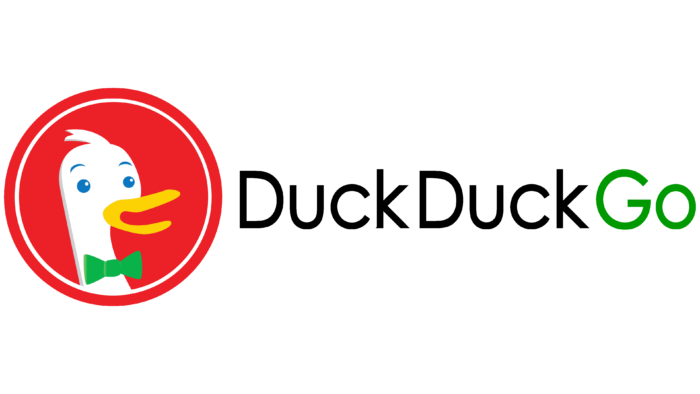The DuckDuckGo logo depicts both a professional approach and humorous simplicity. The platform is an assistant for finding the necessary information. The emblem advises: enter a command, and the cheerful duck will immediately start searching for pages.
DuckDuckGo: Brand overview
| Founded: | September 25, 2008 |
| Founder: | Gabriel Weinberg |
| Headquarters: | Paoli, Pennsylvania, U.S. |
| Website: | duckduckgo.com |
Meaning and History
Even though this search engine was launched relatively recently, the history of the logo has four variants. Thus, the company tried to respond promptly to the trends of the global network, making minimal changes to the previous version of the logo. The main element remained unchanged, namely the image of a duck’s head, which made the platform famous all over the world. This image has remained unchanged since the beginning of DuckDuckGo.
What is DuckDuckGo?
First of all, there are millions of search queries daily. With the help of the platform, anyone can find the answer to their question in a matter of seconds. The intuitive interface allows both experienced users and beginners to surf the Internet.
2008 – 2010
The first version of the logo appeared immediately after the platform’s launch. On a red background, in a frame, is the head of a goose, which looks to the right. The bird’s beak is slightly open. Moreover, this is done at such an angle that it seems that the goose is smiling. Of interest, it is also worth noting the plumage on the head in the form of a forelock and the main “highlight” of the emblem, namely the green bow tie located on the neck.
The original variation of the logo also included a verbal inscription, within which the name of the search engine was presented. Even though all three words are in solid text, without spaces, the user clearly understands where one element ends and the other element begins, thanks to the color scheme. Red, yellow and green colors were used. “DuckDuck” was done in a classic sans-serif font. In turn, the “Go” element was distinguished by its italic font, which created a sense of the volume of the word. In addition, in this element, both characters were written in capital letters, while the first two words, “Duck,” had lowercase letters, not counting the first character.
Under the name, there was an arrow pointing to the right. The left side is darker than the right.
2010 – 2012
Two years after the launch of the original version, it was decided to simplify the search engine logo somewhat. It became somewhat smaller in size because the inscription was located under the image of the goose and not to the left of it. The emblem remains unchanged, except for the addition of a white outline, which makes it more modern than the previous version. At the same time, the verbal inscription was now made out in a single style. A classic sans-serif and rounded font were used. “DuckDuck” consisted of black, while green was used for “Go.”
2012 – 2014
The changes made in 2012 were minimal, and therefore not every user of the search engine noticed the update. The emblem has become brighter compared to the previous version. The style of the word inscription remained identical. At the same time, the color of “DuckDuck” was changed from black to dark gray, and for “Go,” a brighter shade of green was used.
2014 – today
At this stage, minimal changes were also made to the logo. First of all, the color of the frame has become brighter, closer to orange. The white contour in it became thickened, which directly indicated the completion of the project, a high level of quality. In turn, the verbal inscription consisted exclusively of gray color, that is, the changes occurred in the “Go” element.
Font and Colors
A classic sans serif font was used to create the logo at all stages of the DuckDuckGo search engine. As a rule, it was not bold or italic, which only added credibility to the platform in the eyes of potential customers.
The logo’s color palette contained many shades, including white, gray, black, yellow, red, and green. Thus, the platform indicated its versatility, that is, the ability to provide an answer to any question. The key element, namely the search engine logo, would not be so memorable if it were not for the white goose on a red background. With each new stage in the platform’s history, the colors became brighter, indicating the resource’s friendliness to the target audience.
DuckDuckGo color codes
| Flame | Hex color: | #e44c00 |
|---|---|---|
| RGB: | 228 76 0 | |
| CMYK: | 0 67 100 11 | |
| Pantone: | PMS 1655 C |
| Yellow | Hex color: | #ffd200 |
|---|---|---|
| RGB: | 255 210 0 | |
| CMYK: | 0 18 100 0 | |
| Pantone: | PMS 109 C |
| Kelly Green | Hex color: | #53bf16 |
|---|---|---|
| RGB: | 83 191 22 | |
| CMYK: | 57 0 88 25 | |
| Pantone: | PMS 802 C |
| US Air Force Academy Blue | Hex color: | #204d93 |
|---|---|---|
| RGB: | 32 77 147 | |
| CMYK: | 78 48 0 42 | |
| Pantone: | PMS 7686 C |
| Davy’s Gray | Hex color: | #4c4c4c |
|---|---|---|
| RGB: | 76 76 76 | |
| CMYK: | 0 0 0 70 | |
| Pantone: | PMS 7540 C |










